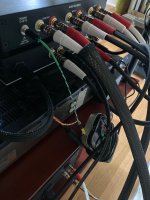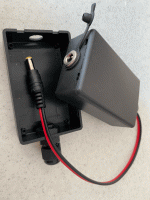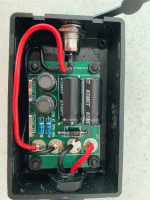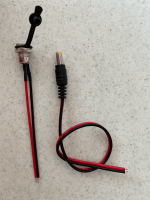I am wondering what the sonic improvement is when using this filter? What do you hear after the filter is installed?
Search this thread for posts made by member ClaudeG , starting on page 5 [ posts #81 and onward ]
This forum is not super big into elucidating about subjective improvements, but you will find them if you look. That said, you will absolutely find a positive increase in sound quality, the filter is amazing.
😎
😎
Very biased post of course as I am one of the enthousiastic posters.
For very various reasons (if counting really at the end then "mostly" for friends to test) I built well over a dozen of these filters. Various friends and I tested them in their system, long term, before adopting them and building some... of course I did so in my own systems etc.
We used this filter single, daisy chained, in front of preamps, commercial DACs that ASR & Co measured perfect, (low) power amps, HP amps and whatever I may forget as it all started nearly 2y ago or so - please use the search function for more details. All devices were fed by quality SMPS (original or better specs, sometimes we tried both options when available... and even some cheap Chinese stuff as 3rd option). Some filters acted directly, cleaning the HF garbage, the usual way. as intented.. others came as addition to an already very tweaked PS with clever and oversized caps and with small bypass for HF etc. so that we really didn't think it could bring any benefit.
Bottom line:
In short and in my very own opinion and experience: Mark's filter is a jem. If used in its scope re amp rating (and of course re voltage), obviously for units fed by an SMPS, it never fails and in the vast majority of cases it brings a hell lot of positive without any drawbacks of any kind. Worst and rare case it brings nothing, but it never harmed, never. Daisy chaining though has to be tried : that isn't a clear cut, I have tried up to 4 filters for my VFET, with various results. Used outside of its spec this filter... is not supposed to be used, so I won't really comment as... what's the point? You don't use your classic Lotus to drive offroad, don't you?
Go for it... experience it by yourself, at that (very low) cost it is really a no brainer! I have many of these, and always 2 ready to go to try at friend's or else. Very versatile tool. Of course, for an ACA mini which enables some nice filtering options to be added cleverly (as suggested by Mark, again, argh!), there may also be other solutions. Many roads leading to Roma... For power amps with oomph, you obviously need to look elsewhere (although Mark again...), but for most units if they are quality ones and fed by an SMPS this is the answer and so effective, "large specter" and cheap one dosn't really need to look back or elsewhere IMHO.
I hope this helps
Claude
For very various reasons (if counting really at the end then "mostly" for friends to test) I built well over a dozen of these filters. Various friends and I tested them in their system, long term, before adopting them and building some... of course I did so in my own systems etc.
We used this filter single, daisy chained, in front of preamps, commercial DACs that ASR & Co measured perfect, (low) power amps, HP amps and whatever I may forget as it all started nearly 2y ago or so - please use the search function for more details. All devices were fed by quality SMPS (original or better specs, sometimes we tried both options when available... and even some cheap Chinese stuff as 3rd option). Some filters acted directly, cleaning the HF garbage, the usual way. as intented.. others came as addition to an already very tweaked PS with clever and oversized caps and with small bypass for HF etc. so that we really didn't think it could bring any benefit.
Bottom line:
- Mark's filter never brought a pure negative or even a negative balance sheet
- It always brought some positive, in most cases quite spectacular benefits, sometimes small welcome steps on already very refined and honed units re PS
- When used it its application field (say in practice respecting the max amp rating, as you don't want to play with the max voltage rating anyway), it ALWAYS brought only positive, and on one very single occasion nothing or little (no positive... but no negative either)... but whatever the unit NEVER negative
- When used outside of the designer's specs, it brought mitigated results, some positive and some negative, but nevertheless no negative balance and that was the only case where it didn't shine absolutely bright and clear cut. BUT using any device outside of the specs is NOT something I would recommend, and I only did so well knowing what I was doing and for pure short term testing purposes before designing myself another filter that would meet the new scope, inspired by Mark's design (again.... argh) and building on its positive while avoiding some obvious bottlenecks
- Daisy chaining though wasn't a clear cut. That clearly depended on the unit and possibly also on subjective tastes and system integration. On the other hand, the filter's attributes when used alone are so clear (although very case different depending on units - auditive gains aren't always the same in nature!) that I wouldn't call them subjective. Yep, I dare say so as all involved listeners, including the ones that didn't want to be included and that passively noticed a difference (read my family) noticed the same huge improvements on every unit...
In short and in my very own opinion and experience: Mark's filter is a jem. If used in its scope re amp rating (and of course re voltage), obviously for units fed by an SMPS, it never fails and in the vast majority of cases it brings a hell lot of positive without any drawbacks of any kind. Worst and rare case it brings nothing, but it never harmed, never. Daisy chaining though has to be tried : that isn't a clear cut, I have tried up to 4 filters for my VFET, with various results. Used outside of its spec this filter... is not supposed to be used, so I won't really comment as... what's the point? You don't use your classic Lotus to drive offroad, don't you?
Go for it... experience it by yourself, at that (very low) cost it is really a no brainer! I have many of these, and always 2 ready to go to try at friend's or else. Very versatile tool. Of course, for an ACA mini which enables some nice filtering options to be added cleverly (as suggested by Mark, again, argh!), there may also be other solutions. Many roads leading to Roma... For power amps with oomph, you obviously need to look elsewhere (although Mark again...), but for most units if they are quality ones and fed by an SMPS this is the answer and so effective, "large specter" and cheap one dosn't really need to look back or elsewhere IMHO.
I hope this helps
Claude
Last edited:
Thank you ClaudeG for your listening results. Your report is most helpful. Since listening is the final arbiter, after all we like to build all of our projects to enjoy listening to them, the sound improvement is the thing I first look and listen for. If a project that I build measures good but sounds bad then it is not used and I go in a different direction seeking good both ways. That being said, is there a frequency response measurement of one of these filters? A real measurement, not a simulation. I am a big fan of passive filters in low wattage power supplies. I have found that when a filter is too restrictive it limits perceived dynamics, but when it is right and before a regulator it really helps the sound. This is with LPS’s, I have not tried one with a switcher, all switchers I have heard bleach the sound.
Yes there is a measurement. It is in this thread. Someone less lazy than me can find it for you. Or you can find it yourself. There are 930 posts; if you examine 1 post every 30 seconds you'll see them all in 8 hours.
Or you could spend USD 10 to buy one from the diyAudio Store. Build it, listen to it, and decide for yourself whether it sounds bad. Once you know how it sounds you may not be as interested in measurements.
Or you could spend USD 10 to buy one from the diyAudio Store. Build it, listen to it, and decide for yourself whether it sounds bad. Once you know how it sounds you may not be as interested in measurements.
Hi Rick,
I am with you: I started as an engineer decades ago and love measurments, but at the end it is all about added value to my ears. You won't be disapointed.
I also share your findings regarding some filters. In Mark's one, I never experienced dynamic issues except in one case when I (ab)used it outside of its specs, demanding probably more than 3A on peaks for a power amp, not something one should do. Note though that some less experienced listeners with us noted a slight recess in bass in some very specific cases... due to less (additional) distosions in fact!
Regarding your question, I am not sure anyone posted a measured frequency response / attenuation sweep over all frequencies, BUT as Mark raised many posted a before / after measurement with various SMPS, from bad ones to recommended ones... so the results apply to the garbage at frequecies these SMPS produce. And they do produce garbage at more frequencies than just their switching frequency.
A first example of these can be found post 40 on a simple SMPS, and there are more of course if you read the thread. But they aren't as many as there are filters. Perhaps people didn't post them / stopped posting them - like myself - as they all look the same on the scope TBH - I don't bother even capturing them. In short: in all cases it did probably an amazing cleaning job and after all the listening result matters more (as one could clean a lot and rob dynamic etc.)
Mark's words are wise: for $10 build one, worth more than (my) 1000 words or the time spent thinking about it, and it is entertaining.
Have fun
Claude
I am with you: I started as an engineer decades ago and love measurments, but at the end it is all about added value to my ears. You won't be disapointed.
I also share your findings regarding some filters. In Mark's one, I never experienced dynamic issues except in one case when I (ab)used it outside of its specs, demanding probably more than 3A on peaks for a power amp, not something one should do. Note though that some less experienced listeners with us noted a slight recess in bass in some very specific cases... due to less (additional) distosions in fact!
Regarding your question, I am not sure anyone posted a measured frequency response / attenuation sweep over all frequencies, BUT as Mark raised many posted a before / after measurement with various SMPS, from bad ones to recommended ones... so the results apply to the garbage at frequecies these SMPS produce. And they do produce garbage at more frequencies than just their switching frequency.
A first example of these can be found post 40 on a simple SMPS, and there are more of course if you read the thread. But they aren't as many as there are filters. Perhaps people didn't post them / stopped posting them - like myself - as they all look the same on the scope TBH - I don't bother even capturing them. In short: in all cases it did probably an amazing cleaning job and after all the listening result matters more (as one could clean a lot and rob dynamic etc.)
Mark's words are wise: for $10 build one, worth more than (my) 1000 words or the time spent thinking about it, and it is entertaining.
Have fun
Claude
Last edited:
This looks like an amazing litle project.
I can see it like a beautifull match for meanwell irm modules in one board altogether. Has anyone ever made this? Might have a go on it.
One thing thet i cant understand (I'm a rookie on this world, forgive me in advance), why are those top 0R040 used? Do they act like a fuse or something?
I can see it like a beautifull match for meanwell irm modules in one board altogether. Has anyone ever made this? Might have a go on it.
One thing thet i cant understand (I'm a rookie on this world, forgive me in advance), why are those top 0R040 used? Do they act like a fuse or something?
Nicely done, including double layers of heatshrink where the cables enter the metal box. Like photo 4 of post #1 inthis thread.
Hi. The store is sold out of the kits so i was looking to go down the pcb + components path to give it a try. I’m having trouble finding the 12mm current sense resistors… Any suggested alternative part? Thanks
Your first, best choice is to visit octopart.com . Train your fingers to type their URL, it is an incredibly helpful site.
I did not re-read all 47 pages of this thread before posting but I don't remember a post exactly like the following. That may be because the solution I present below is pretty obvious to most of you. A while back, I ordered 3 P089ZB boards from the store and populated them with parts. I then pondered how to use them. On a number of completed projects I could have inserted the boards inside the case. That's a safe and easy way to use Mark's incredible filter. It occurred to me that I would have to order a lot of boards to stuff them in all the completed projects that use an external SMPS. In some projects there is no space for the filter. I would usually only use one or two filters at a time. I looked around for a pre-made box that could be plugged and unplugged and moved between devices easily but couldn't find anything that looked right. I have no access to metal and wood working equipment so I ended up buying pre-made parts from Amazon that did the job. I did a search on Amazon and took the first part that looked like it would work; there may be better alternatives. I didn't not optimize for cost. Each completed box would cost about $4.25each in quantities of 20.
https://www.amazon.com/Socket-Threa...ie=UTF8&reviewerType=all_reviews&pageNumber=2
https://www.amazon.com/gp/product/B07F462RYR/ref=ppx_yo_dt_b_asin_title_o08_s00?ie=UTF8&psc=1
https://www.amazon.com/gp/product/B08K8J45L5/ref=ppx_yo_dt_b_asin_title_o08_s00?ie=UTF8&psc=1
I am not an engineer. Safety is a concern that you will have to judge for yourself. The box works fine for me in my application which to date has been a max SMPS rated 48V at 3A. The electrical parts received a 4.7/5.0 rating by purchasers on Amazon. The female plug is wired with 18ga wire and is rated by the supplier for 9A with no max voltage specified. The male plug leads are 20ga rated for 5A by the seller. One reviewer claims the male wire is 0.020" (25ga) and the female is 0.032" (21ga). Another reviewer commented that the male plug wire heats up at 10A. If you think anything about this box is unsafe please let me know. The box could be constructed with self-wired plugs and lower ga wire, however, the P089ZB is rated for no more than 48V/3A.
Construction was simple as befits my skills. I drilled 4 holes corresponding to the mounting holes on the board in the bottom of the plastic boxes. Holes for the male leads and female plugs were drilled on opposite ends of the box. A locking strain relief was inserted in one end for the male pigtail plug; the female plug on the other end is secured with a nut. The boards were secured in the box with nylon screws, 6m standoffs and a nut. The leads were cut to length, trimmed and soldered to the boards from the top side. I suppose some would add ferrites to the cables but I didn't.
https://www.amazon.com/Socket-Threa...ie=UTF8&reviewerType=all_reviews&pageNumber=2
https://www.amazon.com/gp/product/B07F462RYR/ref=ppx_yo_dt_b_asin_title_o08_s00?ie=UTF8&psc=1
https://www.amazon.com/gp/product/B08K8J45L5/ref=ppx_yo_dt_b_asin_title_o08_s00?ie=UTF8&psc=1
I am not an engineer. Safety is a concern that you will have to judge for yourself. The box works fine for me in my application which to date has been a max SMPS rated 48V at 3A. The electrical parts received a 4.7/5.0 rating by purchasers on Amazon. The female plug is wired with 18ga wire and is rated by the supplier for 9A with no max voltage specified. The male plug leads are 20ga rated for 5A by the seller. One reviewer claims the male wire is 0.020" (25ga) and the female is 0.032" (21ga). Another reviewer commented that the male plug wire heats up at 10A. If you think anything about this box is unsafe please let me know. The box could be constructed with self-wired plugs and lower ga wire, however, the P089ZB is rated for no more than 48V/3A.
Construction was simple as befits my skills. I drilled 4 holes corresponding to the mounting holes on the board in the bottom of the plastic boxes. Holes for the male leads and female plugs were drilled on opposite ends of the box. A locking strain relief was inserted in one end for the male pigtail plug; the female plug on the other end is secured with a nut. The boards were secured in the box with nylon screws, 6m standoffs and a nut. The leads were cut to length, trimmed and soldered to the boards from the top side. I suppose some would add ferrites to the cables but I didn't.
Attachments
Wow! Thanks for a tremendously helpful set of links and photos, @Audiobear !! Builders now have another excellent option to consider, when planning their SMPS filter deployment.
I have just edited post #1 of this thread, and installed a link to your super useful message. New builders and new readers of this thread, can learn from your fantastic example. Muchas Gracias and Vielen Dank!
I have just edited post #1 of this thread, and installed a link to your super useful message. New builders and new readers of this thread, can learn from your fantastic example. Muchas Gracias and Vielen Dank!
Last edited:
If anyone wants to nominate additional DIY builds of PO89ZB to be also mentioned prominently in post #1, please sing out! (Ideally, posts in this thread with photos). Don't be bashful about nominating your own build+photos either. If they're great then new builders ought to see them.
Thanks Mark. That’s a good site. But unfortunately the hits on the current sense resistor part number are still coming up as zero stock everywhere. Maybe I’m not doing something quite right to broaden the search..Your first, best choice is to visit octopart.com . Train your fingers to type their URL, it is an incredibly helpful site.
https://www.mouser.com/ProductDetail/605-RMCJ1U00R04FSThanks Mark. That’s a good site. But unfortunately the hits on the current sense resistor part number are still coming up as zero stock everywhere. Maybe I’m not doing something quite right to broaden the search..
Different part but no worries.
Thanks!
- Home
- Source & Line
- Analog Line Level
- PO89ZB, an inline DC filter for SMPS wall warts. Preamps, HPA, Korg NuTube, etc



